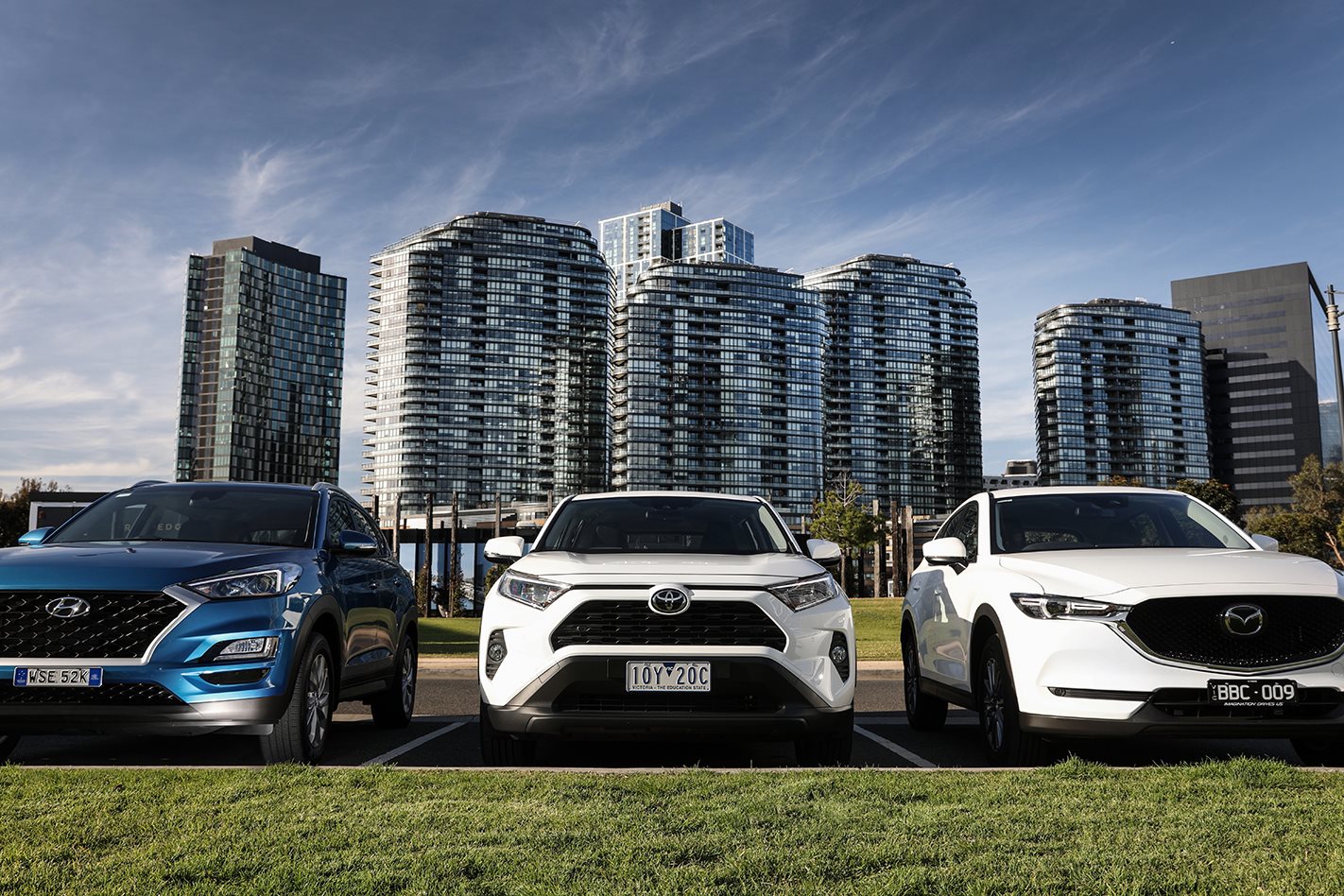One of the more memorable recurring features in this magazine’s long and illustrious history was the ‘King of the Hill’ series, started in the late 1970s, pitting a desirable-spec Holden against the Ford Falcon equivalent.
As made clear in editor Peter Robinson’s opening paragraph back in the January 1978 original, the comparison helped ascertain whose model range was better, down to the bread-and-butter HZ Kingswood SL and XC Falcon 500 that made up the bulk of Australia’s two top sellers’ volumes. The GTS and GXL V8s as tested representing them respectively were simply their makers’ best feet forward. Readers loved it. It also sold many magazines.
The world has changed unrecognisably since, of course, with big sedans all but dead and the local heroes gone, replaced in the hearts and minds of Aussie consumers with SUVs. The juggernaut started with the pioneering Toyota RAV4’s debut in 1994. Now everybody’s at it, and demand is showing no signs of letting up.
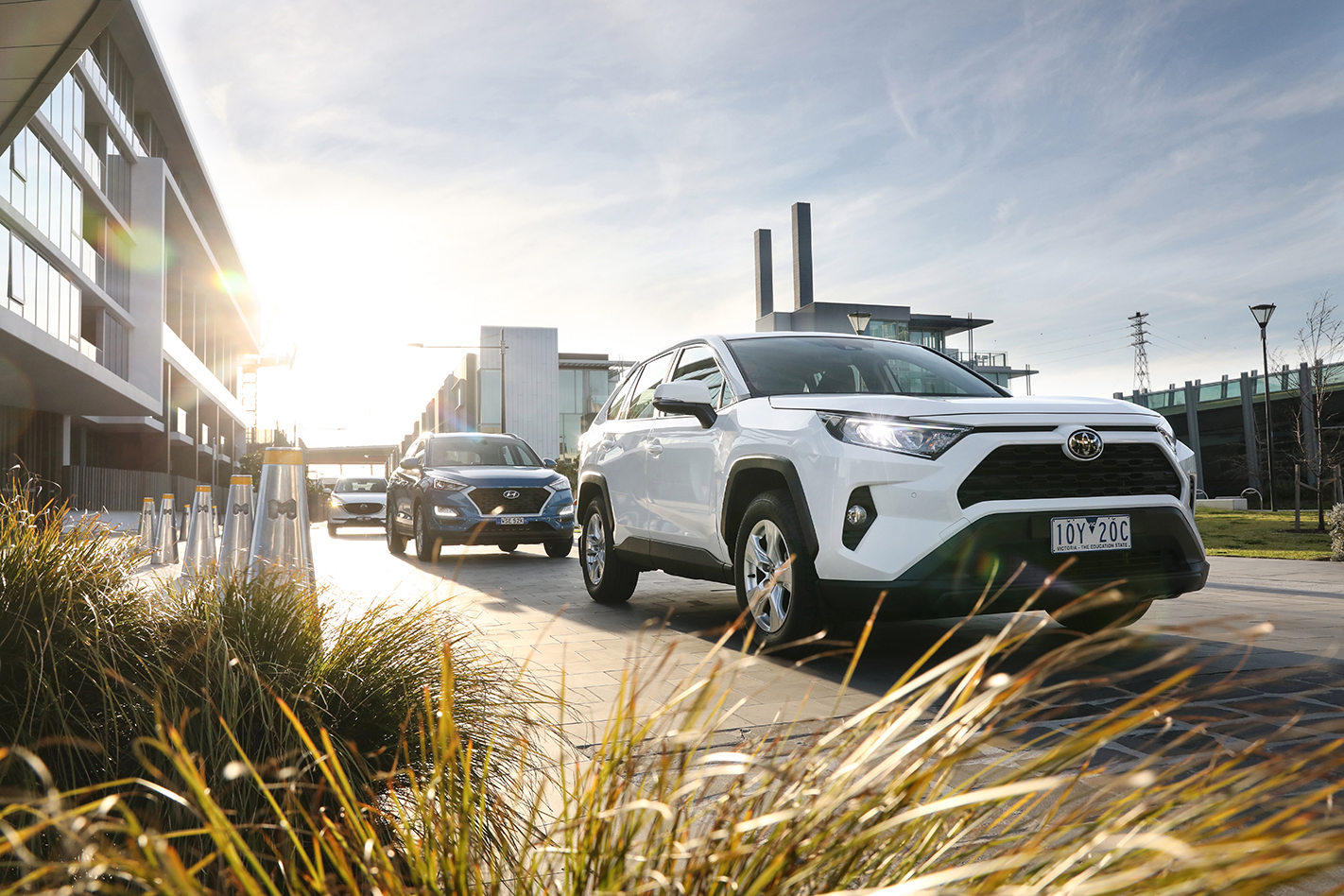
Welcome, then, to King of the Hills – or Heights, Vales, Meadows, Lakes, Creeks or whatever suburbia suffix applies. Instead of V8s, we’ve assembled a trio of family-friendly, lifestyle-enhancing medium SUVs, and in their most modest, affordable and relevant specification at that – base front-drive autos. Scoff all you will, traditionalists, because even with just two naturally aspirated litres and half the cylinder count, one managed an HZ GTS 5.0L-matching 400-metre time of 16.8s, while consuming only one-third of the fuel. But we’re getting ahead of ourselves…
Newest, and therefore motivator, for this contest is the RAV4 – the fifth generation in a frankly unremarkable lineage given the earliest model’s significance. Launched in May, the all-new 50 series brandishes the company’s wider, lower and stronger TNGA platform, along with Jeep-like styling cues.
This is the second time we’ve run RAV4 through the comparison mill. Earlier this year, the flagship Cruiser Hybrid all-wheel drive edged out the Subaru Forester 2.5i-S, while showing its Mazda CX-5, Volkswagen Tiguan and Hyundai Tucson equivalents a clean set of tracks (Wheels, June 2019).
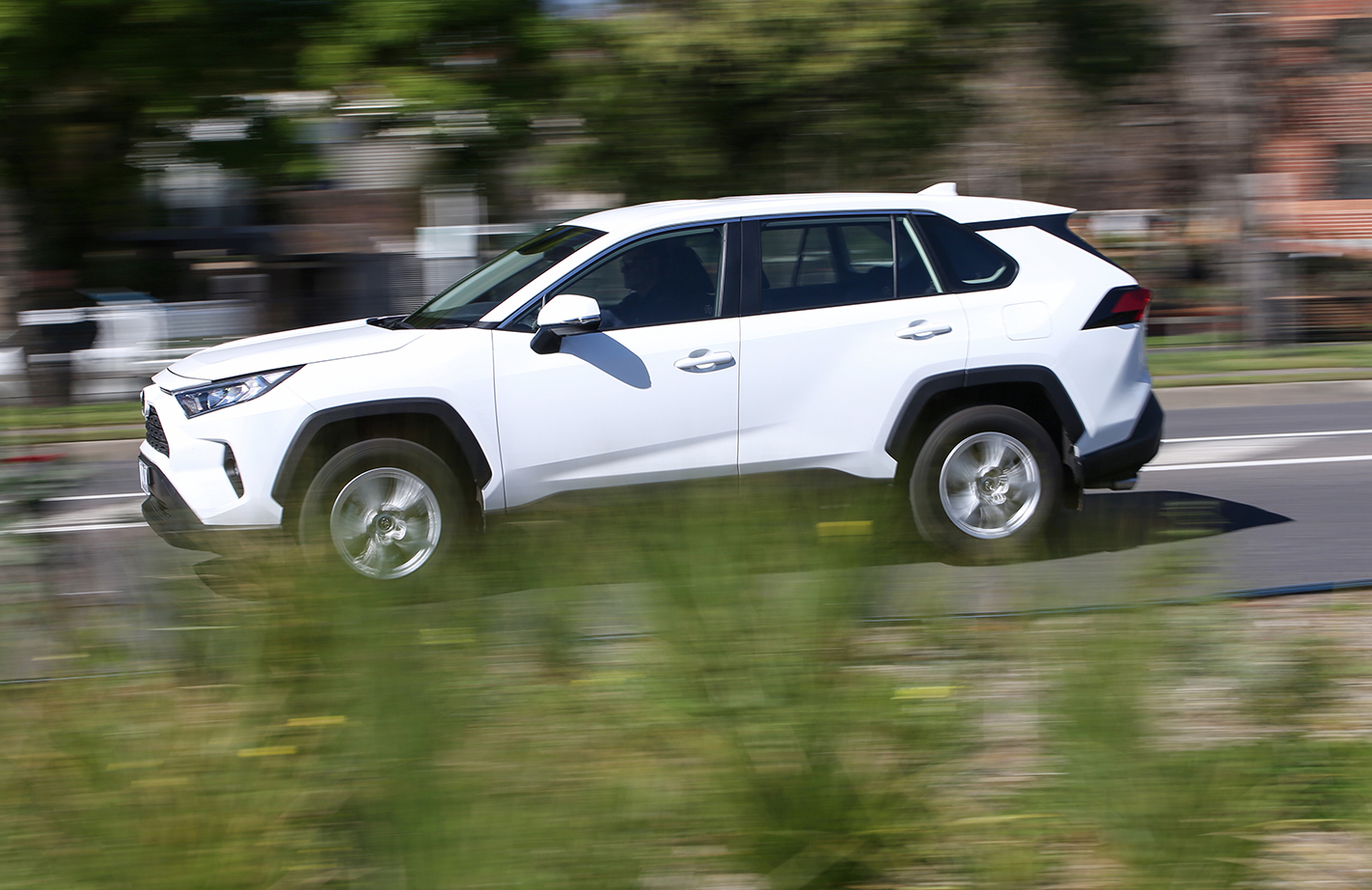
The thing is, in our experience, the less money spent on a medium SUV, the more mediocre it is. Bereft of sparking any joy, they’re like everyday reminders that you should have studied harder back at school. So, how does the cheapest RAV4 stack up? Our fridge-white GX 2WD auto arrived with zero options, which means $32,640 (before on-road costs), yet brings autonomous emergency braking (AEB), lane-keep assist, seven airbags (including for driver’s knee), reverse camera, rear sensors, auto headlights/wipers, Apple CarPlay/Android Auto (early-build models without it are eligible for a free dealer retrofit) and 17-inch alloys.
Just $240 more buys you entry into Australia’s best-selling SUV, the CX-5. Launched in early 2017, the second-gen KF redesign addresses most of the noise/vibration/harshness and rear-seat packaging issues of the hyper-popular 2012-original, without compromising the winning formula of athletic premium-economy family travel.
The $32,880 Maxx 2WD auto wasn’t available, leaving us with the $3210-dearer Maxx Sport upgrade you see here, so please ignore the latter’s climate control, rear-seat armrest and vents, sat-nav, remote rear-seat releases and darkened alloys because the Maxx misses out on these – along with the knee airbag, speed-sign recognition and front sensors found in the RAV4. Over the latter, however, the slickly styled CX-5 gains a leather wheel and is the sole SUV present with a front passenger-seat height adjuster, push-button start, 40/20/40 (instead of 60/40) split-fold backrests, reverse-gear AEB and fuel-saving/emissions-cutting stop/start at idle. Sophisticated stuff.
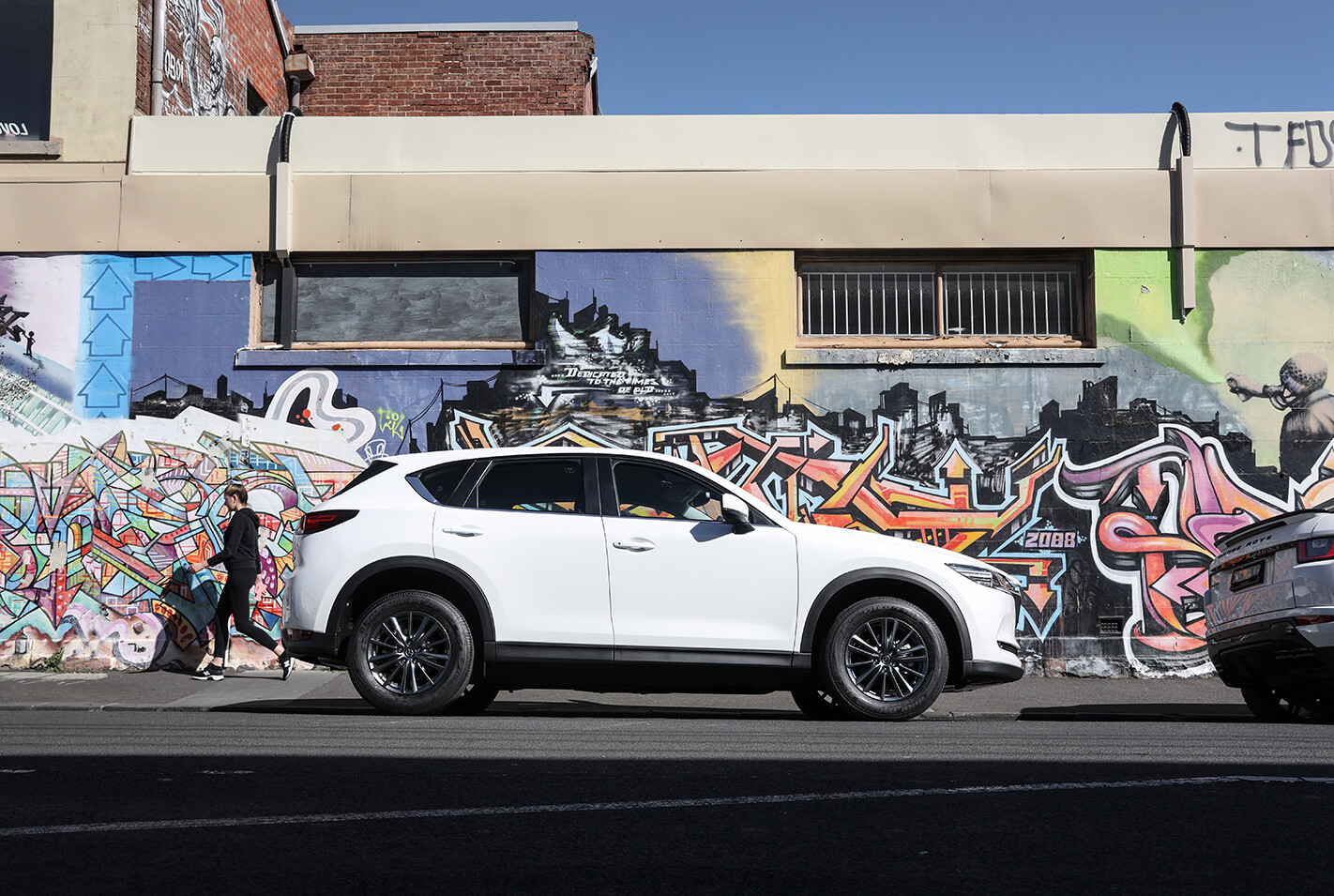
Last up is the TL Tucson, surfacing in 2015 and facelifted mid last year with a remodelled front, revised dash, uprated safety and – since July’s TL4 update – standardised driver-assist tech including AEB. The old Go’s gone, returning the Active as the range opener, from $31,790. Still a handsome design, the Hyundai basically aligns itself with the CX-5 Maxx spec-wise (though adds alloys and roof rails), but is alone here without the blindspot monitoring, rear cross-traffic alert, adaptive cruise control, auto high beam, digital radio, electric folding mirrors, tyre-pressure monitors and one-touch power window convenience the other pair proffer. In terms of standard kit, it’s an edge to Toyota.
The story is similar when assessing interior packaging, with clear space between the RAV4 and its rivals, and not just because of the former’s growth spurt over the narrow old version. For the record, the wheelbase isn’t even the longest of the trio. No, the big difference is down to getting the basics right – comfort, utility, quality and ease. From entry/egress, driving position, seat support, ventilation and vision to unexpectedly high equipment levels, the wide, airy GX pretty much lacks for nothing. Our only worry is the missing front passenger-seat height adjuster, which might see taller scalps scrape ceilings. Otherwise, it’s clear the RAV4 has been expertly engineered from the inside out.
In contrast, the other two are palpably less wagon-oid, so seem almost half a class more compact, with shallower glass resulting in a more hemmed-in feel for back-seat passengers, though neither is space deficient in actual terms.
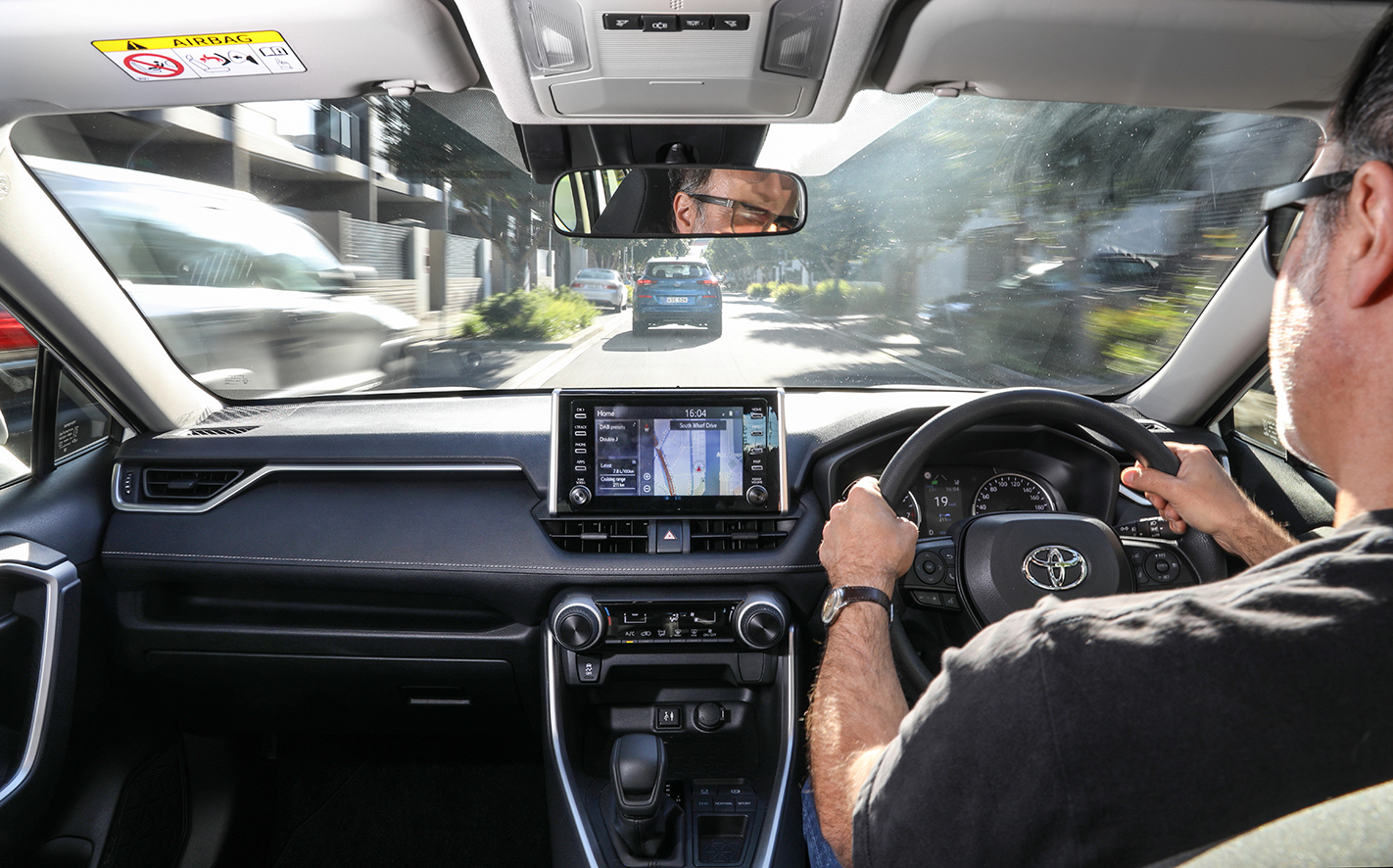
Going for a lower-slung and sportier vibe, the CX-5’s seating and dash are the most car-like, aided by an Audi-style wide central console bisecting the front occupants. Adding to that Euro feel is the group’s only ‘i-Drive’-style controller for the (small and dated) multimedia system, firmly comfy cushions and sufficient storage. But the bulky dash is now showing its age, rear vision trails the Toyota’s, the back cushion is flattest and there’s marginally less kneeroom. As with all three, the CX-5’s backrests recline, though only the Mazda’s is divided into three, not two, bringing unique versatility.
Almost as spacious as the RAV4 and offering cushy seating all-round, okay vision and heaps of places for odds and ends, the Tucson nonetheless is now looking tired, with a dating dash layout and the lowest-rent materials culminating in the most downmarket ambience on test. The Tucson is also the loudest for road noise, and like the base CX-5, forgoes rear air vents too. Boo.
While the Hyundai offers impressive rear legroom, it doesn’t come at the cost of cargo capacity, beating the Mazda by a small bit, though – again – most observers wouldn’t notice the difference. A RAV4 owner, however, would.
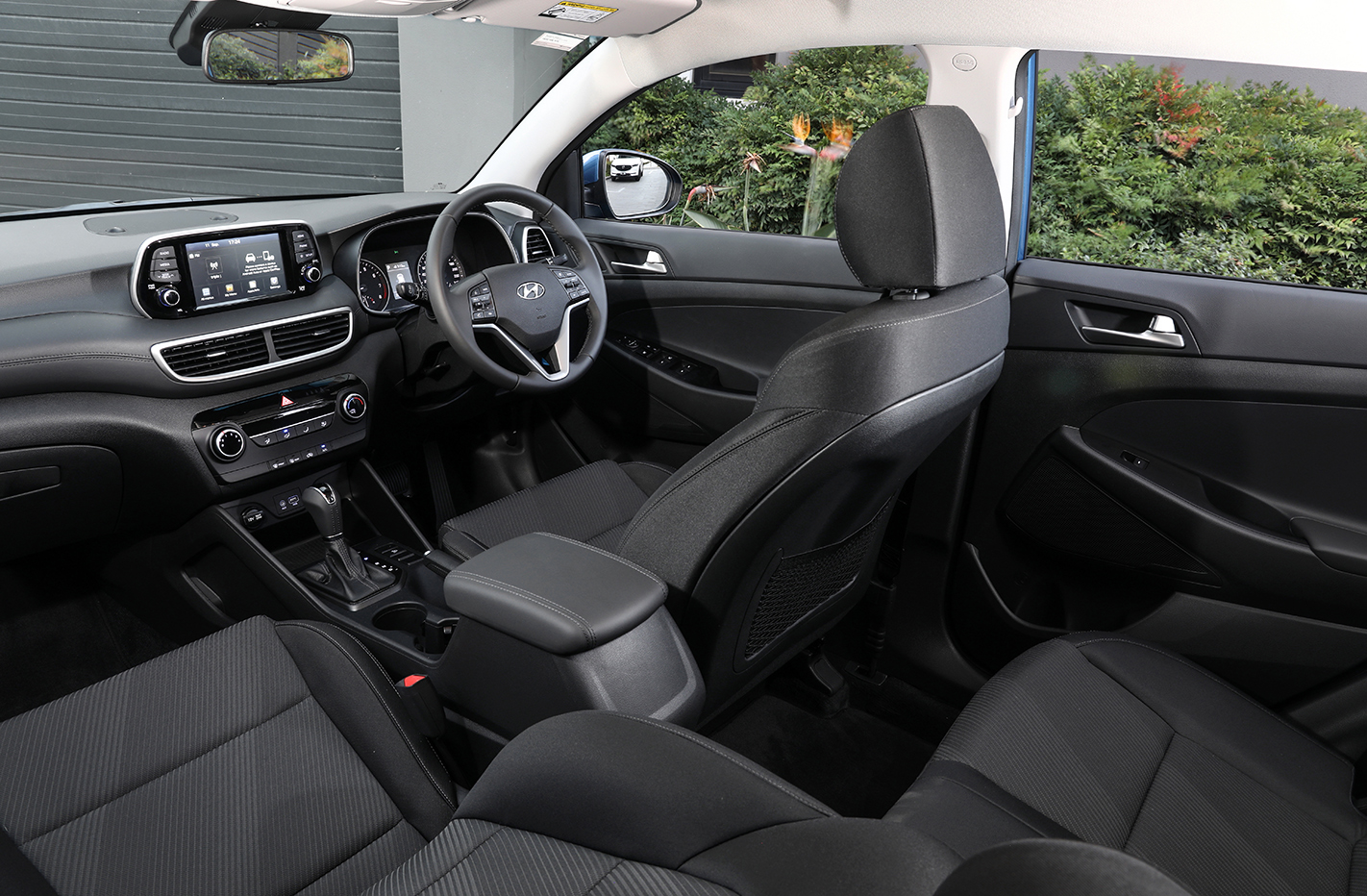
Speaking of boots, or more to the point, booting it, performance is one area where most base-model mid-sized SUVs have (literally) lagged behind their more salubrious larger-engined variants, and it’s easy to see why. Slotting a 2.0-litre atmo donk from a hatch into a larger, bulkier wagon means it has to work, drink and whine that much harder than a 2.5L.
That said, the CX-5’s 1998cc unit is one of the more pleasant of the breed, since it yearns to rev, isn’t strained visiting the 6700rpm cut-out and feels livelier and more reactive to driver inputs on the move than the numbers suggest. To that end, the chosen ratio can be held from bumping off the limiter in manual mode (with the preferred upshift-down/downshift-up motion), while selecting ‘Sport’ extends the revs in each gear before auto change-up for more oomph. So, it’s odd that the slowest SUV on test also seems the sportiest.
Against the stopwatch, while the 122kW/205Nm 2.0-litre/six-speed auto-equipped Hyundai is a hair’s breadth quicker than the Mazda, that’s still disappointing given the former’s loftier outputs and fewer kilos. In fact, the Active never seems as strong as the Maxx Sport behind the wheel, even though the 1999cc ‘Nu’ unit is noticeably noisier (and coarser) and thus more dramatic at higher revs than either of its Japanese rivals. Indeed, the only important increment where the CX-5 actually beats the Tucson is between 80 and 120km/h, and by only 0.1sec. Its greater urge is an illusion.
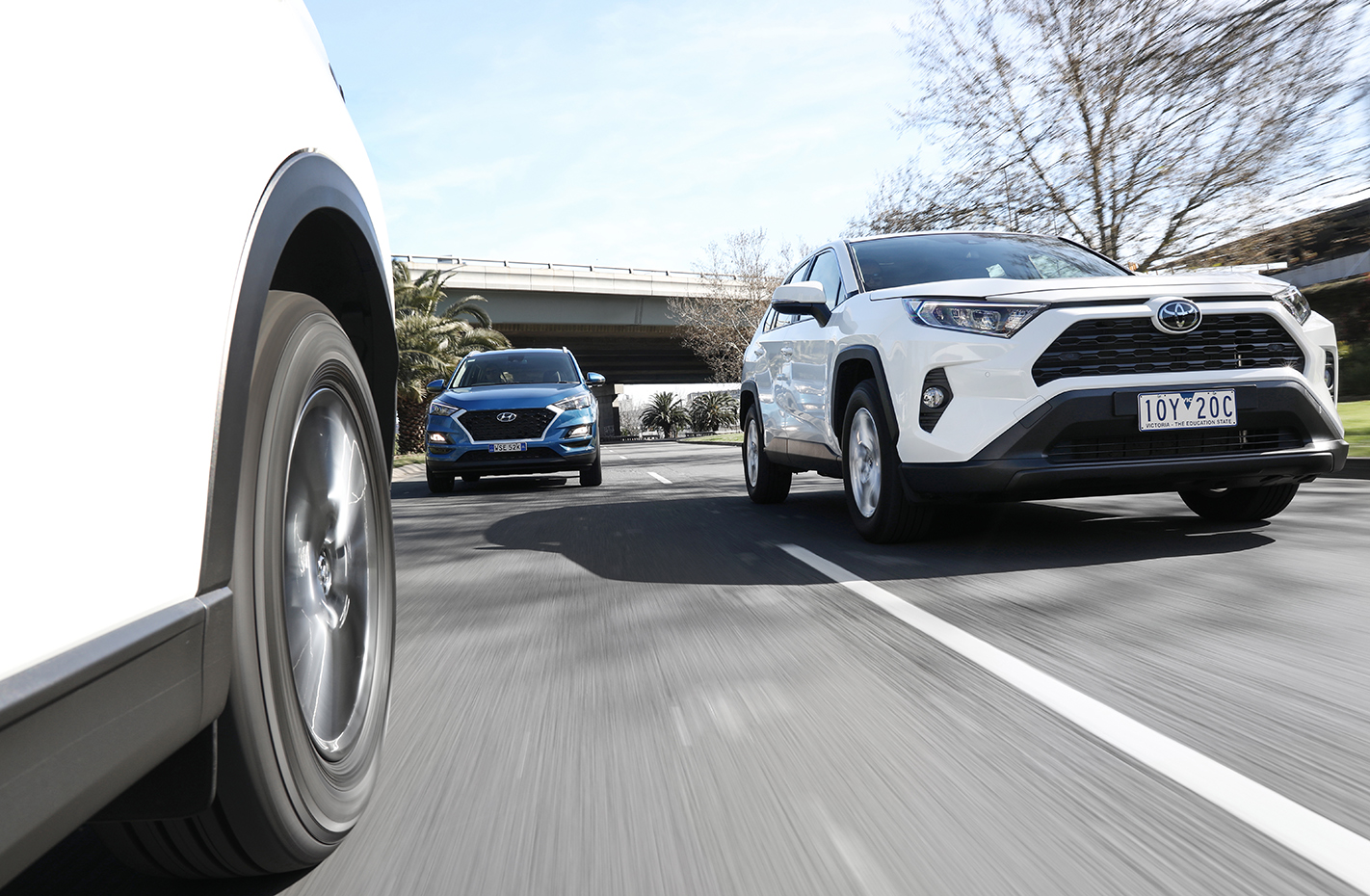
Clouding matters is the Hyundai’s indecisive transmission calibration, meaning it can hunt erratically between ratios at even a whiff of an incline or a touch of the throttle. At such times, when the CX-5 is crooning the Tucson is crowing. For powertrains so close on paper, their characters are very different out in the real world.
Personality is what we didn’t expect from the Toyota, not with a boring continuously variable transmission (CVT) that’s normally to excitement what Greta Thunberg is to climate-change deniers. However, the RAV4 shakes things up with a new torque-converter low-range gear. Combined with the so-called Dynamic Force 127kW/203Nm 1987cc heart, it turns CVT preconceptions and prejudices on their presumptuous heads.
Armed with 10 stepped ‘ratios’, the ‘Direct Shift’ CVT makes the most of the muscular, rev-happy 2.0L for comparatively strong, sustained thrust across a broad bandwidth of revs – especially above 4000rpm. The resulting kick sees the Toyota nearly a whole second quicker to 100 and 3.0sec ahead at 140. It’s as if a much beefier engine beats behind that bluff grille.
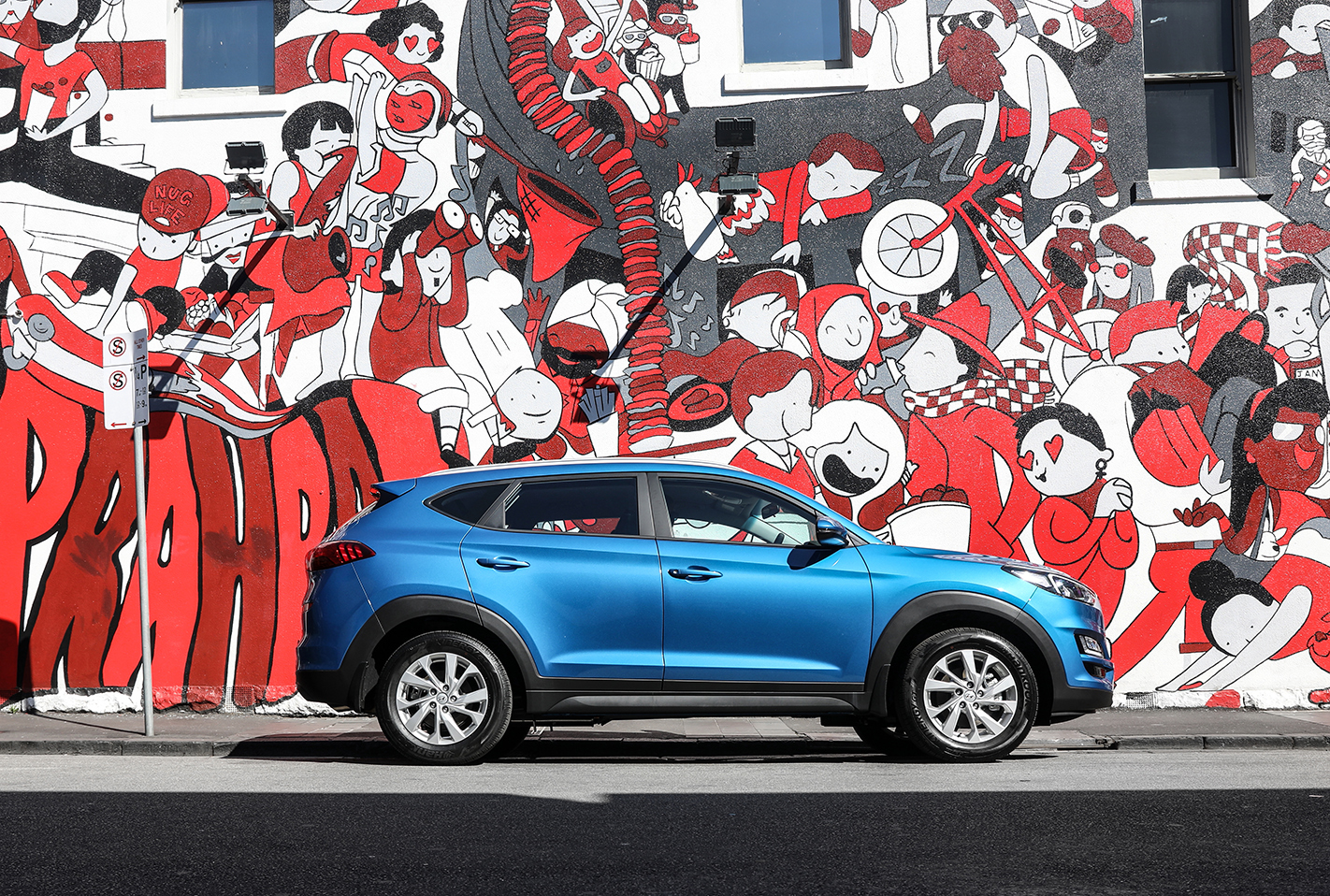
But here’s the rub. Factor in just 8.2L/100km against the others’ 10L/100km, and it’s obvious that the RAV4 no longer punishes the punter for choosing the least pricey option. Sure, its snarly engine note isn’t as melodic as the Mazda’s, and inevitably there’s still some CVT-related droning when stomping the pedal, but the GX’s sparkling, effervescent powertrain is nothing shy of revelatory.
The Dynamic Force label could also apply to the Toyota’s, er, dynamics too, though the GX’s steering isn’t quite as sharp or tactile as the Tucson’s terrifically linear tiller. Hyundai’s local engineering crew has helped bestow handling that’s more on the sportier spectrum than you might expect from a humdrum SUV, yet still with a high degree of predictability. Plus, keen drivers can turn the wick up for a little scrappy fun – without fear of overcooking things. Inevitably, the flipside is a firmer and regularly unsettled ride over rougher roads. And lots of road roar.
Considering the CX-5’s eager powertrain, its steering becomes too light and remote at speed. As noted in earlier comparos, when hoofing along, its front and rear ends seem out of sync, sometimes necessitating constant corrections through a corner, sapping driver confidence. Roadholding and grip levels do remain contained, though, while the Mazda’s suspension ushers in a suppler and more sophisticated ride quality across a wider arc of operating conditions than the Tucson’s. As we’re assessing family hacks here, calm comfort outweighs the Hyundai’s higher athletic thresholds.
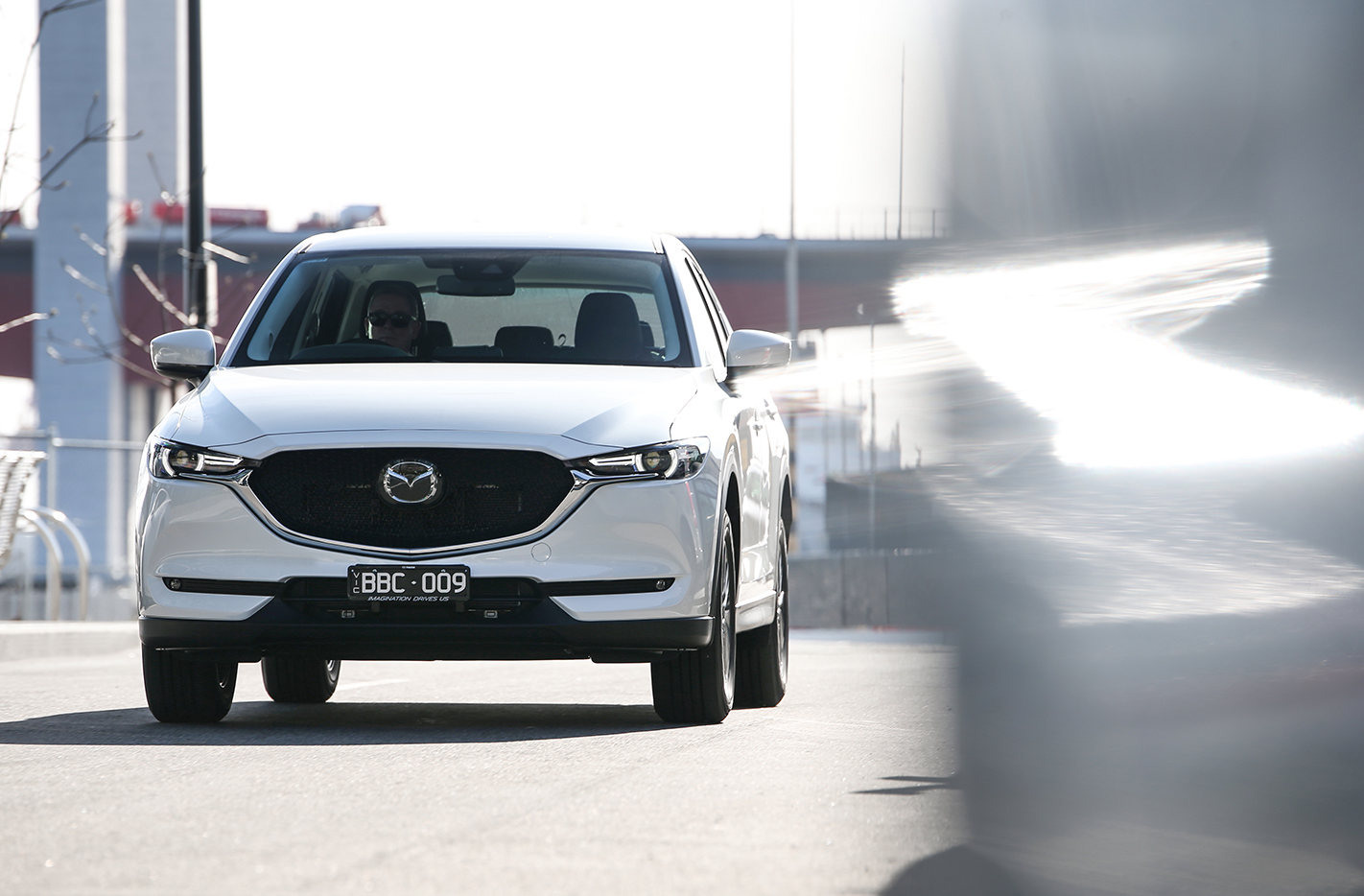
Does this mean a clean sweep for the Toyota? If you value fluid, cohesive handling, unflappable roadholding and a controlled absorbent ride, then yes, for the RAV4 balances all three with towering assurance. We found ourselves driving the same stretches of winding switchbacks at significantly higher speeds than in either of its rivals, thanks to a chassis that reacts and responds to the driver as well as the prevailing conditions safely and predictably. Alongside the Tucson, the GX’s steering is less feelsome and direct, but as an overall dynamic package, we can’t see how even the most enthusiastic driver wouldn’t come away satisfied. Mums and dads should love it.
After the cruddy old version, could we really be talking about a base RAV4? Consistent cohesion are the keys to the latest GX 2WD’s resounding victory, conquering in all departments with an ambition and scope hitherto foreign to any previous Toyota SUV. The Tucson remains an appealing if dated package, and the more polished CX-5 is better still overall, but the RAV4 easily reigns supreme.
Urban Australia, rejoice. To paraphrase Liza Minnelli, what was once top of the heaps is now king of the hills.
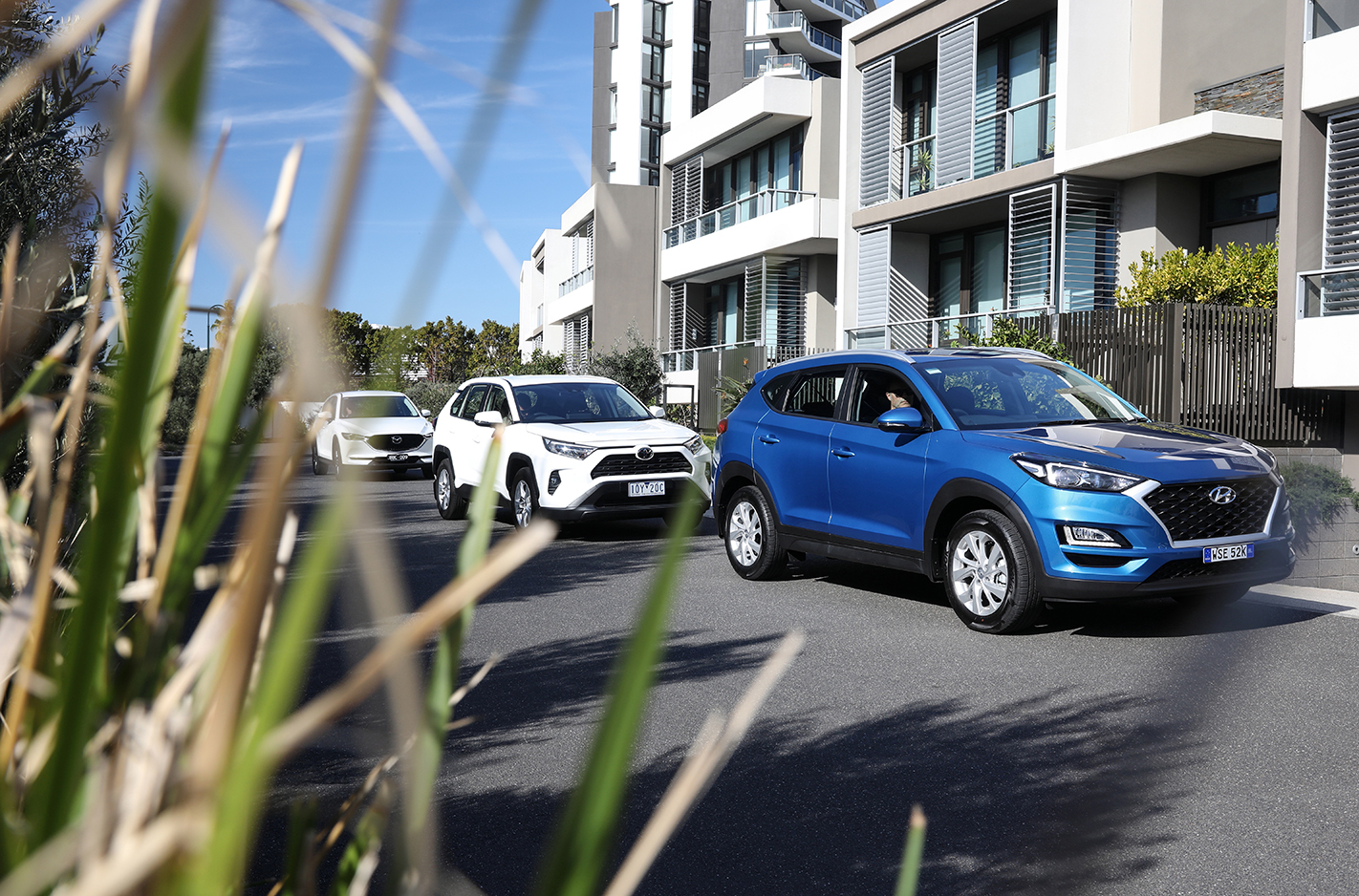
REST OF THE BEST (SELLERS)
As for the other top sellers in this segment, we decided against including the excellent Forester 2.5i for being AWD-only. The Mitsubishi Outlander ES, Nissan X-Trail ST and Kia Sportage S are ageing, and Honda’s CR-V VTi lags in safety (still no AEB); of our preferred Euros, Peugeot’s 3008 Active is too pricey, VW’s base Tiguan 110TSI remained unavailable due to WLTP delays at time of planning, and Ford’s Escape Ambiente is in runout ahead of 2020’s ground-up redesign.
CHANGING RATIOS
As with the related Corolla, Toyota’s innovative new CVT tech uses a fixed launch gear that emulates a regular torque-converter gearbox, for snappy responses, before seamlessly switching to the steel belt pulley system central to the CVT’s smooth efficiency between 10km/h and 60km/h. The low gear is re-engaged if you floor the throttle under 40km/h. There are also Eco, Normal and Sport modes – though the latter promises more than it delivers.
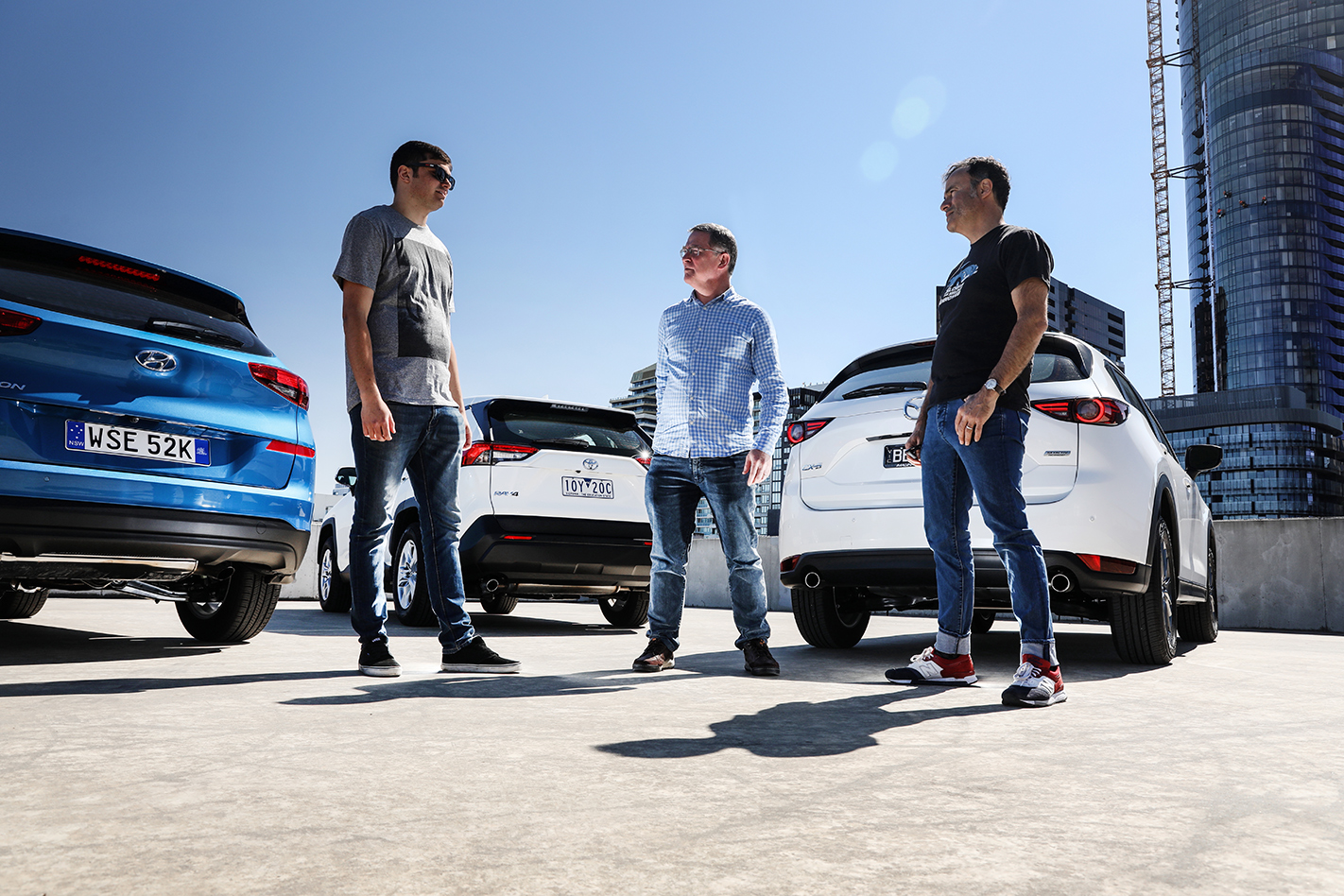
INTERIOR COMPARISON
Hyundai Tucson
Like a jumped-up i30, the updated Active’s dash is big on familiarity, simplicity, functionality and user friendliness. Cabin is spacious and comfy to boot, with the trio’s most reclinable rear backrest, though the ambience is the least inviting, and not helped by the lack of air vents and too much road noise. Group’s only manual handbrake underlines Tucson’s dynamic focus. Boot is a surprising 488L. The spare is full-sized. Ground clearance is 172mm.
Mazda CX-5
Low-slung, sporty and cosiest of the three, yet amply spacious, even the base Maxx seems the most upmarket inside (Maxx Sport pictured), with beautiful dials, racy wheel and most tactile trim. Seats impress, but dated multimedia and no digital speedo nor rear vents are oversights. Doors open wide for best entry/egress, with massive mirrors. Cargo blind is brilliantly effective, and cargo capacity is 442L. Space-saver spare. Ground clearance is 185mm.
Toyota RAV4
Airier RAV4 is thoughtfully designed around peoples’ needs, while sleek dash melds minimalism with ergonomic smarts. Sole SUV here with rear armrest and air vents, while equipment levels are the most generous. Space, storage, seating, vision and refinement also test best but wind noise, no front passenger-seat height adjuster, plastic wheel and vague heater indicator level may annoy. Spare is a space-saver, cargo capacity is 580L and ground clearance is 195mm.
SCORECARD
- Toyota RAV4 GX: 9.0/10
- Mazda CX-5 Maxx Sport: 7.5/10
- Hyundai Tucson Active: 6.5/10
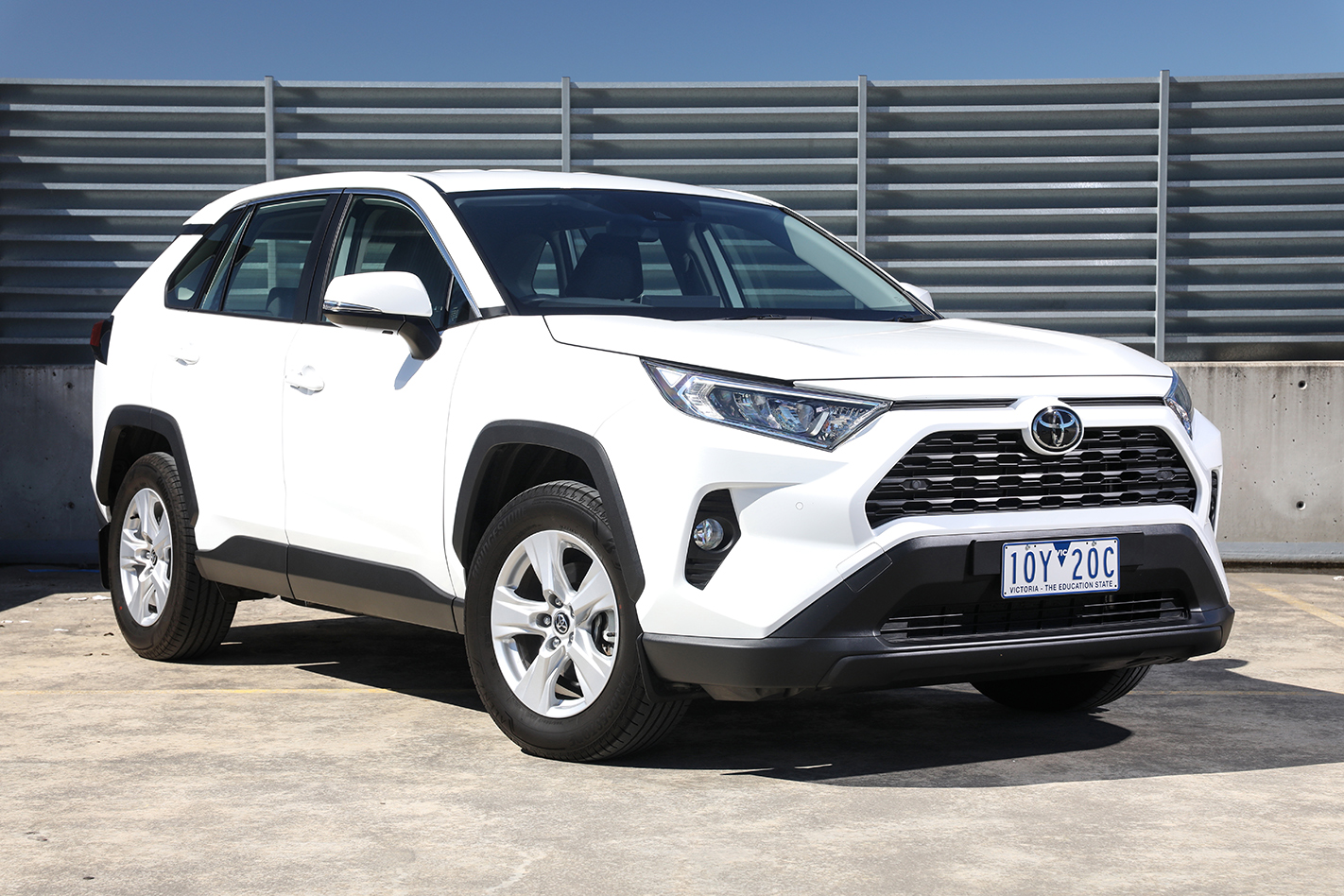
SPECS, PRICES, AND PERFORMANCE
| Car | Toyota RAV4 GX | Mazda CX-5 Maxx Sport | Hyundai Tucson Active |
| Price | $32,640 ($32,640 as tested) | $36,090 ($36,090 as tested) | $31,790 ($32,385 as tested) |
| Engine | In-line 4cyl, dohc, 16v | in-line 4cyl, dohc, 16v | in-line 4cyl, dohc, 16v |
| Layout | Front engine (east-west); front drive | Front engine (east-west); front drive | Front engine (east-west); front drive |
| Capacity | 1987cc | 1998cc | 1999cc |
| Power | 127kW @ 6600rpm | 115kW @ 6000rpm | 122kW @ 6200rpm |
| Torque | 203Nm @ 4800rpm | 200Nm @ 4000rpm | 205Nm @ 4000rpm |
| Transmission | CVT | 6-speed automatic | 6-speed automatic |
| Body | Steel, 5 doors, 5 seats | Steel, 5 doors, 5 seats | Steel, 5 doors, 5 seats |
| L/W/H/Wu2013B | 4600/1855/1685/2690mm | 4550/1840/1675/2700mm | 4480/1850/1665/2670mm |
| Track (F/R) | 1605/1625mm | 1595/1595mm | 1608/1620mm |
| Weight | 1550kg | 1559kg | 1490kg |
| Boot | 580 litres | 442 litres | 488 litres |
| Fuel/tank | 91 octane/55 litres | 91 octane/56 litres | 91 octane/62 litres |
| Economy | 8.2L/100km (test average) | 10.0L/100km (test average) | 10.0L/100km (test average) |
| Front suspension | Struts, coil springs, anti-roll bar | Struts, A-arms, anti-roll bar | Struts, A-arms, anti-roll bar |
| Rear suspension | Double A-arms, coil springs, anti-roll bar | Multi-link, coil springs, anti-roll baru00a0 | Multi-link, coil springs, anti-roll bar |
| Steering | electric rack and pinion | electric rack and pinion | electric rack and pinion |
| Turn circle | 11.0m (2.7 turns lock-to-lock) | 11.0m (2.7 turns lock-to-lock) | 11.0m (2.6 turns lock-to-lock) |
| Front brakes | ventilated discs (305mm) | ventilated discs (297mm) | ventilated discs (305mm) |
| Rear brakes | discs (281mm) | discs (303mm) | discs (302mm) |
| Tyres | Bridgestone Alenza 001 | Yokohama Geolander G98 | Hankook Kinergy GT |
| Tyre size | 225/65R17 102H | 225/65R17 102H | 225/60R17 99H |
| ANCAP rating | 5 Stars | 5 Stars | 5 Stars |
| Power-to-weight | 82kW per tonne | 74kW per tonne | 82kW per tonne |
| Redline/cut-out | 6700/6700rpm | 6500/6700rpm | 6500/6500rpm |
| Speed at indicated 100km/h | 98km/h | 98km/h | 96km/h |
| 0-20km/h | 1.1sec | 1.3sec | 1.2sec |
| 0-40km/h | 2.7sec | 2.8sec | 2.8sec |
| 0-60km/h | 4.4sec | 4.8sec | 4.6sec |
| 0-80km/h | 6.7sec | 7.2sec | 7.0sec |
| 0-100km/h | 9.4sec | 10.3sec | 10.2sec |
| 0-120km/h | 13.0sec | 14.2sec | 14.1sec |
| 0-140km/h | 17.7sec | 20.5sec | 19.7sec |
| 0-400m | 16.8sec @ 135.5km/h | 17.4sec @ 137.7km/h | 17.3sec @ 133.3km/h |
| 80-120km/h | 6.1sec | 7.0sec | 7.1sec |
| Braking distance 100km/h-0 | 35.9m | 36.4m | 35.9m |

